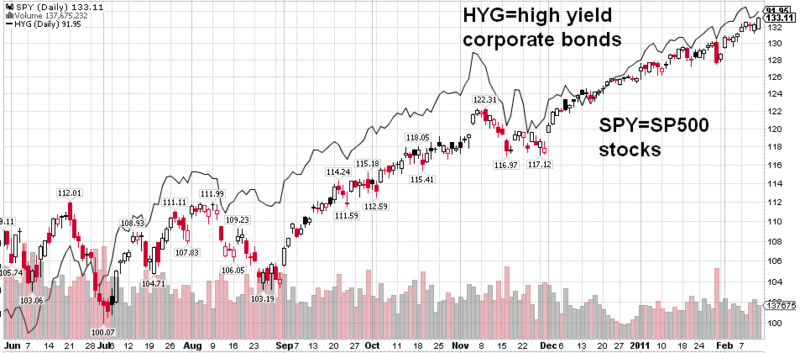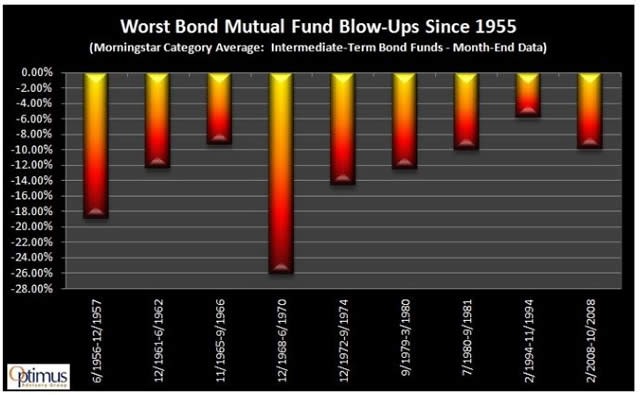Have We Entered A Bond Bear Market Money and Markets Financial Advice
Post on: 24 Июль, 2015 No Comment

Sharon Daniels, President
Weiss Capital Management
Bond investors were poised to hit the panic button last week … nervously watching as yields on 10-Year U.S. Treasury bonds briefly pierced the 4 percent level for the first time in well over a year.
Their concerns are understandable. After all, the threat of rising rates has been hanging over fixed-income markets ever since the Fed began printing money at hyper-speed during the financial crisis. And the fears haven’t subsided.
The big question on everybody’s mind: Is the end near for the bond market?
Not imminently. But we clearly see signs that long-term interest rates will be heading higher eventually given the massive federal deficits in the U.S. and our country’s reliance on foreign lenders.
Despite these worries, credit markets are currently stable. In fact, the 10-year Treasury bond auction at the end of last week was very well received and supported by strong buying interest from foreign investors — the strongest demand in at least 16 years. 1
So perhaps the bond market has been granted another reprieve … at least for now. Still, the ultimate day of reckoning for the bond market is coming … but it’s likely to be over time … not overnight. The key for fixed-income investors is not to panic over the short-term trading range moves in bond prices.
But it makes prudent sense to begin taking steps to help protect your portfolio against rising interest rates when they occur.
What this really boils down to is TIMING. It’s important to understand where and how to make the right moves with your fixed-income holdings. Some important questions to consider now include:
- Which bonds and maturities perform best at different points in the business cycle?
- What are the best fixed-income choices?
- And which securities should do well as the recovery unfolds?
Seeking Increased Income Now …
While Guarding Against Rising Rates Later
As president of Weiss Capital Management †. an SEC Registered Investment Adviser for more than 25 years, my investment team and I regularly guide our clients through markets that are in transition, like they are now.
Massive amounts of government stimulus spending to combat the financial crisis will inevitably lead to higher inflation and higher interest rates down the road … no question. But it’s likely to happen in different countries and at different times. Again, timing is the key.
In the U.S. we don’t foresee a sudden surge in inflation or interest rates in the very near future, but it is on the horizon. Right now, economic fundamentals still appear too weak for inflation to take hold, and the Fed intends to keep interest rates low for an “extended period” as they’ve repeatedly broadcast. Right now, deflation is still public enemy number one in the U.S.
You can see the ongoing threat of deflation clearly in the graph. The broad measure of M2 U.S. money supply is contracting at a record rate … in spite of the Fed’s runaway printing press.
The trouble is the Fed’s funny money isn’t getting circulated back into the real economy … why? Because it’s locked up in bank vaults as outstanding bank credit contracts at close to a 5 percent annual rate! 2
So what should prudent investors be doing with their fixed-income portfolio now?
Here are four steps we believe you should consider to potentially increase your income in today’s low yield environment … while still helping to protect yourself against higher interest rates down the road …
#1 — Start with the right investment vehicle. We recommend that all but the very largest portfolios utilize mutual funds. They give you professional management and a diversified mix of fixed-income holdings, which can help reduce interest rate and credit risks — two risks you must watch out for.
#2 — Spread your fixed-income dollars across a broad mix of securities with different maturities. This tactic can help increase your income potential without significantly increasing your risk. We suggest owning a mix of corporate and government bond funds, preferably with shorter durations.
Of course, the shorter your maturities, the lower the yield, but shorter maturities are also less sensitive to price changes as interest rates fluctuate. By adding medium-term maturities and international or emerging market bonds, you may be able to kick up your cash flow even more. But note that higher yields can add more risk too and the same goes for international bonds, which are also sensitive to currency fluctuations.
#3 — Keep your overall portfolio maturity under about 5 years. Maturity, or duration, is measured in years and it is a standard data point provided by mutual funds on their websites. It’s a bit more difficult to calculate it across your entire portfolio of fund holdings.
At Weiss Capital, our professional oversight helps determine the right blend of income-producing securities and maturities to strike a balance between risk and return potential within the portfolio while helping you maintain cash flow.
#4 — Consider allocating a small portion of your portfolio to inverse funds and foreign currency funds. Such specialty funds, if used prudently, can provide a hedge against currency fluctuations and also hedge against rising interest rates.
A small allocation toward these funds is recommended. A word of caution though: They must be used sparingly, chosen carefully and, above all, monitored quite closely. These types of investments are typically not suitable for retail investors who plan to hold them longer than one trading session. Still, when used wisely, or with professional guidance, inverse funds may help reduce the volatility in your portfolio overall. Weiss Capital Management has extensive experience utilizing these securities in pursuit of overall investment objectives.
Choosing the appropriate mix of fixed-income investments that is right for you and maintaining proper diversification can be a challenging task in today’s volatile markets. For professional guidance from experienced investment managers, you may also want to consider a professionally-managed income strategy.
Providing Higher Cash Flow Income Despite

Today’s Low Yield Environment
Weiss Diversified Income Builder . offered exclusively by Weiss Capital Management, is a unique fixed-income strategy that’s focused on cash flow yield … or the level of available income produced each year.
Diversified Income Builder’s cash flow yield stood at 5.8 percent recently … more than TWICE the yield on a 5-year Treasury note of just 2.6 percent. * However it’s important to understand that this is the average 12-month yield estimate of the investments held in the Weiss Diversified Income Builder portfolio, and it’s a moving target that can fluctuate depending on market conditions, interest rate levels, and changes to portfolio holdings.
Diversified Income Builder invests in a wide variety of income-producing mutual funds, rather than individual bonds to provide an extra layer of diversification. This includes a broad mix of global bond funds that can provide higher yields than are available here in the U.S.
If you look beyond our borders, you’ll find many countries that may be healthier than the U.S. with stronger currencies than the dollar, and with naturally higher interest rate environments.
Of course, if you are looking for global diversification using international bond funds, these have unique risks to consider; including differences in accounting standards, political risks, and less corporate transparency in some countries outside the U.S. Investors should understand these differences.
At Weiss Capital, we seek to minimize these risks and the risk of rising interest rates as much as possible through broad diversification among different types of bond funds — both corporate and government — from different regions of the world. We also take a very active approach in managing the investments for our clients — we can change the mix of securities swiftly should our outlook change. Just keep in mind that you can lose money in Weiss Diversified Income Builder, the same as with any investment strategy. And, unlike bank CDs, this strategy is not FDIC insured.
However, if you want to help protect your money from rising interest rates with a potential higher level of current income than most money market funds or bank CDs, then you may want to learn more about Weiss Diversified Income Builder . We recently published a special report that discusses this strategy in more detail. You can request a copy at no cost by visiting this link. Or please feel free to contact us by calling 1-800-814-3045 and a Weiss financial advisor will be happy to answer your specific questions.
Best wishes,
Sharon A. Daniels
President
† Weiss Capital Management (an SEC-Registered Investment Adviser) is a separate but affiliated entity of Weiss Research, the publisher of Money and Markets. Both entities are owned by Weiss Group, LLC.
* This yield is a forward-looking estimation and is not guaranteed. It is based on the yields of the holdings in the portfolio as of 3/29/2010 and will fluctuate based on changes in portfolio holdings and the market. See the Complete Performance of the Weiss Diversified Income Builder by clicking here.
www.bloomberg.com/apps/news?pid=20601009&sid=a25BXtcOXnd0
2 BCA Research: U.S. Investment Strategy, 3/22/10
About Money and Markets
Money and Markets (MaM) is published by Weiss Research, Inc. and written by Martin D. Weiss along with Nilus Mattive, Claus Vogt, Ron Rowland, Michael Larson and Bryan Rich. To avoid conflicts of interest, Weiss Research and its staff do not hold positions in companies recommended in MaM. nor do we accept any compensation for such recommendations. The comments, graphs, forecasts, and indices published in MaM are based upon data whose accuracy is deemed reliable but not guaranteed. Performance returns cited are derived from our best estimates but must be considered hypothetical in as much as we do not track the actual prices investors pay or receive. Regular contributors and staff include Andrea Baumwald, John Burke, Marci Campbell, Amy Carlino, Selene Ceballo, Amber Dakar, Dinesh Kalera, Red Morgan, Maryellen Murphy, Jennifer Newman-Amos, Adam Shafer, Julie Trudeau, Jill Umiker, Leslie Underwood and Michelle Zausnig.
Attention editors and publishers! Money and Markets issues can be republished. Republished issues MUST include attribution of the author(s) and the following short paragraph:
www.moneyandmarkets.com.
From time to time, Money and Markets may have information from select third-party advertisers known as “external sponsorships.” We cannot guarantee the accuracy of these ads. In addition, these ads do not necessarily express the viewpoints of Money and Markets or its editors. For more information, see our terms and conditions.
© 2010 by Weiss Research, Inc. All rights reserved.














